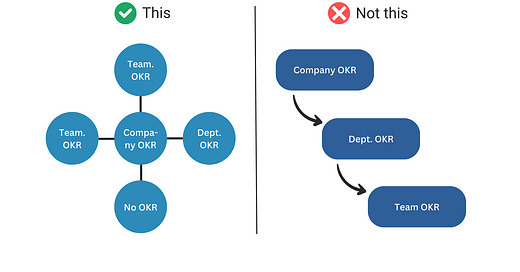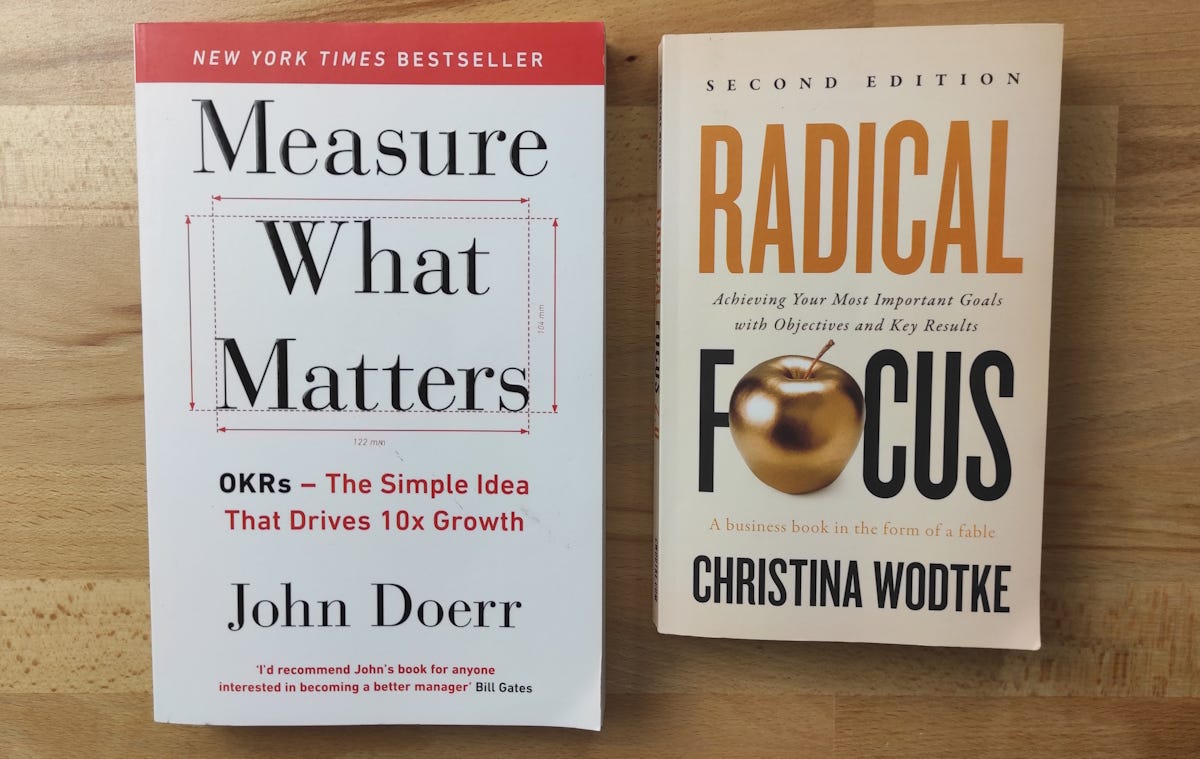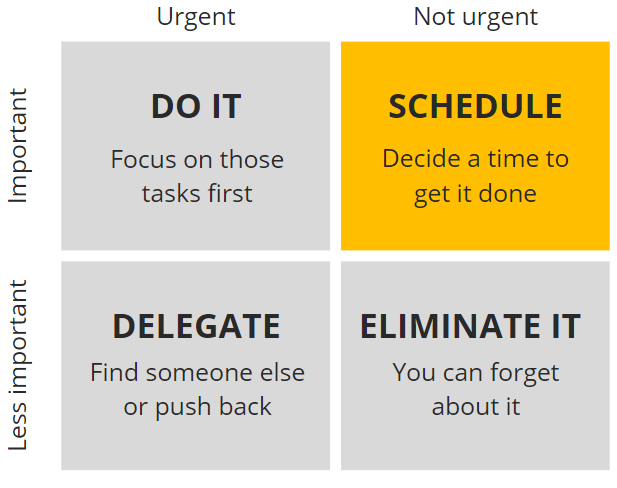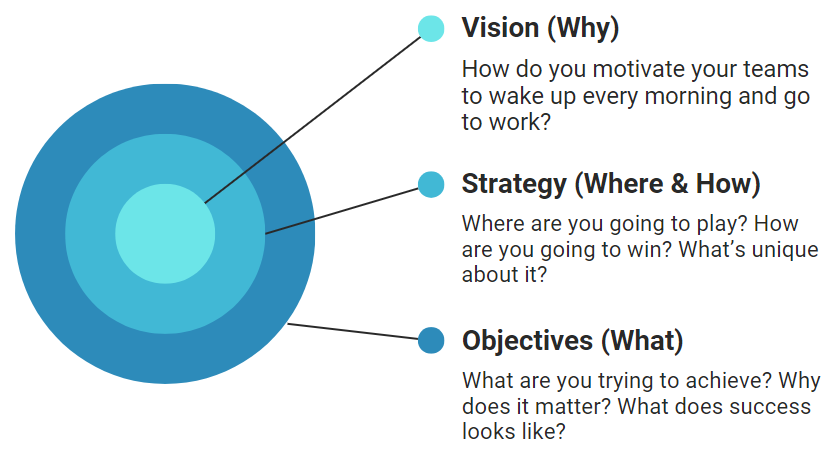Objectives and Key Results (OKRs) 101
What Are OKRs? A Quarter Step-by-Step. Best Practices and Common Mistakes. OKRs and Scrum. OKRs and Product Discovery.
Welcome to The Product Compass! Every week I share actionable insights and resources to help you learn and grow as a Product Manager.
In Today’s newsletter:
1. Two Approaches to OKRs
2. Why Do We Need OKRs?
3. What Exactly Are OKRs?
3.1 Prerequisites
3.2 How to create Objectives?
3.3 How to create Key Results?
🔒 And only for premium subscribers:
4. OKRs: Step-by-Step
5. OKRs: Best Practices and Common Mistakes
6. OKRs: Advanced Techniques
6.1 OKRs and Scrum
6.2 OKRs and Product Roadmap
6.3 OKRs and Continuous Product Discovery
6.4 Extending the traditional OKRs
6.5 OKRs vs. alternatives
1. Two Approaches to OKRs
Before writing this post, I had to choose between the two books:
Measure What Matters by John Doerr
Radical Focus by Christina Wodtke, 2nd edition
I've selected Radical Focus:
It's easy to understand and more actionable.
It emphasizes empowering people with OKRs and answering the “Why,” not just “What” we want to achieve.
We can easily use it with other methods like Scrum and Product Discovery. This makes it suitable for product teams.
It encourages working on one goal at a time, facilitating focus and the team members working together rather than on individual initiatives.
It’s supported by Marty Cagan, who wrote the foreword and an entire chapter, “OKRs for Product Teams,” and Teresa Torres.
Many believe that Google created OKRs. However, as Christina Wodtke has explained, they started at Intel. John Doerr popularized them in companies he invested in, such as Google and Zynga.
In Radical Focus, Christina talked about her time at Zynga:
“When I quit Zynga, I was burned out physically and mentally.” - Christina Wodtke, Radical Focus
Radical Focus got recommendations from Marty Cagan and Teresa Torres.
Measure What Matters was recommended by Bill Gates.
Christina Wodtke teaches product management at Stanford University.
John Doerr is a famous writer and investor. Right now, he writes about the climate, which is important but different from product management.
I hope you will trust my judgment.
From here on, I will use “OKRs” to refer to the methodology defined by Christina Wodtke and “OKR set” to talk about a group of individual Objectives with their corresponding Key Results.
In any case, points 2, 3, and 6 are pretty universal.
2. Why Do We Need OKRs?
In Radical Focus, Christina Wodtke lists five reasons why we can't get things done:
We haven’t prioritized our goals:
Context: If everything is important, then nothing is.
Solution: With OKRs, you order the goals and focus on one at a time. Thus, “Radical Focus.”
We don't talk about our goal enough (original: We haven’t communicated the goal obsessively and comprehensively)
Context: It’s not enough to merely state the goal once and then forget it.
Solution: In OKRs, the goal is continuously reiterated throughout all activities.
We don’t have a plan to get things done:
Context: The original OKR system was primarily a method to set smart goals. It didn't provide insights on how actually to achieve them.
Solution: OKRs methodology introduces a structured process, which includes check-ins, celebrations, and commitments, to track progress continuously.
We haven’t made time for what matters:
Context: Urgent and important tasks are usually easily completed. But we often struggle with tasks that are important but not urgent, such as strategizing.
Solution: The OKR methodology ensures that these tasks can be planned and actually achieved.
We don't keep trying: (original: We give up instead of iterating)
Context: The most common pitfall is setting the goal once and not tracking the progress toward the objective. We either fail or succeed without adjustments.
Solution: By consistently monitoring the results and progress toward the goal using OKRs, teams can fail, learn from it, try again, and ultimately improve.
3. What Exactly Are OKRs?
OKR stands for “Objectives and Key Results.” The two ingredients are:
Objective - A qualitative, inspirational goal for a team to focus on.
Key Results - Quantitative metrics (typically three) that monitor progress towards the Objective.
For example:
Objective: Delight new users with the onboarding flow
Key results:
Customer Satisfaction (CSAT) >= 75%.
66%+ onboardings completed within two days.
An average Time to Value (TTV) <= 20 minutes.
OKRs are fundamentally about:
Setting a single, inspiring goal.
Empowering a team to determine the optimal approach to achieve it.
Continuously monitoring the progress, learning from failures, and improving.
3.1 Prerequisites to working with OKRs
3.1.1 Empowerment
OKRs don't work without a culture of empowerment. In companies with a dysfunctional organizational culture, OKRs might become just another tool to impose control over employees.
3.1.2 Vision and strategy
Before defining your first OKR, it's essential to establish a vision and strategy.
Sounds obvious, but many companies don’t have one.
I previously:
Wrote about product vision and strategy in Debunking 17 Common Misconceptions in Product Management. Specifically, I explained how vision and mission statements are often confused and why I (just like Roman Pichler and Roger Martin) prefer a single term. Similarly, Christina Wodtke uses the term “mission.”
Explained what strategy is in the Product Strategy Canvas.
While the vision provides a long-term "Why," the OKR motivates and guides a team in the short term, typically over a quarter, defining:
Why it's important.
What we need to achieve.
How will we measure we succeeded.
I’ll discuss combining the OKR set with a Roadmap in "6. OKRs: Advanced Techniques."
3.2 How to create Objectives?
Here are four basic rules when making an OKR:
Keep it short: Make sure each Objective is just one clear sentence. This makes it easy for everyone to understand and remember.
Make it inspiring: Objectives should inspire and motivate teams. They should provide a clear vision without being too prescriptive. They should make people feel excited.
Set a time limit: Parkinson's Law suggests that work will expand to fill the time allotted for completion. That’s why it's crucial to have time-bound OKR. This helps the team focus and get things done. Usually, the cadence is three months, but big companies might choose a longer period.
Let one team own it: A single team should be able to work on an OKR without needing much help from others. This enables agility and a sense of ownership and facilitates quicker decision-making.
Good examples:
Delight new users with the improved onboarding flow.
Get students excited to finish their homework.
Create an awesome MVP landing page that delights the users.
Ensure exceptional customer support.
Bad examples:
Implement the new onboarding flow according to the specification: It’s an uninspiring, predefined output (project) that doesn’t make a good Objective.
More than 70% of home assignments are completed on time: It’s a quantitative metric, so it's better as a Key Result, not an Objective.
More than 30% of the visitors sign up for a free trial: This is also a metric, so it's a Key Result.
CSAT >= 70: This metric fits as a Key Result.
3.3 How to create Key Results?
Key Results, usually three, tell you whether you have met the Objective.
Ask yourself: What would success look like?
A Key Result is everything you can measure, including Acquisition, Activation, Engagement, Retention, Revenue, Referral, Lean and Agile metrics, and any other technical or business metric specific to your Objective
For instance:
Objective: Ensure exceptional customer support.
Key Results:
50%+ of the tickets are resolved automatically.
80% of support tickets resolved <= 4 hours.
Customers rate us 4.5 out of 5 or higher.
Tips:
💡 As Teresa Torres argues in Continuous Discovery Habits, it’s best to brainstorm individually and only later meet and aggregate the results. Generate as many Key Result candidates as possible, and refine them later. A good number is ~20.
💡 A good source of inspiration might be my previous issue, The Ultimate List of Product Metrics.
💡 In her book, Christina Wodtke also quotes an “excellent book Lean Analytics.” One of its authors,
, wrote a free post for The Product Compass (no paywall): Are You Tracking the Right Metrics?💡 Key Results should be hard to achieve but not impossible. About 50% chance of succeeding, assuming you focus and work hard on the Objective, is a good number.
💡 If you don’t have a baseline, guess the expected value of a metric. By the end of a quarter, you will be much smarter.
💡 Finally, consider the consequences of your Key Results. Optimizing for a single metric (e.g., Revenue) might lead to negative outcomes in the long run. You can use additional techniques, like pairing indicators and health metrics (those are just key metrics that measure your product’s performance). In my opinion, these challenges are less significant when you align your metrics with the North Star Metric and the corresponding Input Metrics. By design, they represent customer value and are leading indicators of long-term business success.
4. OKRs: A Quarter Step-by-Step
4.1 How to start?
Keep reading with a 7-day free trial
Subscribe to The Product Compass to keep reading this post and get 7 days of free access to the full post archives.






